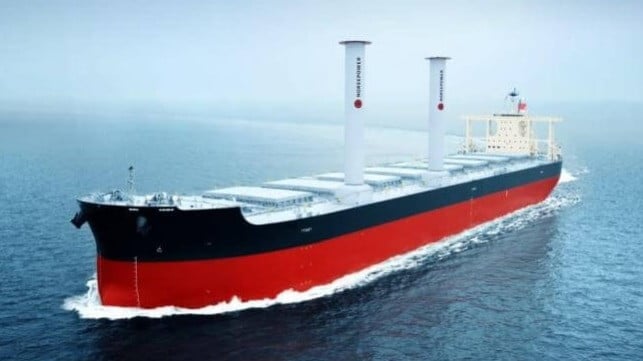Project to Retrofit Rotors to MOL Bulker Chartered to Vale

Efforts to expand the use of wind-assisted propulsion are continuing with the news that Japan’s Mitsui O.S.K. Lines (MOL) has agreed to retrofit two rotor sails to one of its large dry bulk carriers operating under charter to Brazilian mining giant Vale. The retrofit follows a study launched more than a year ago by the two companies that was exploring the use of wind propulsion systems employing rotor sails on large bulk carriers.
The companies agree to install two Flettner-style rotors built by Norsepower aboard an existing 200,000 dwt bulker. The installation is expected in the first half of 2024. The vessel is currently in the mid–term of a contract for the transportation of iron ore for Vale.
This project calls for two rotors each standing nearly 115 feet with a diameter of approximately 16.4 feet. Norsepower reports the rotors will be made of lightweight and strong composite material and employ a fully automated control system. The company, which was established a decade ago in Norway, explains that the rotor produces thrust as the wind moving around the cylinder generates differential pressure.
The system will be combined with voyage optimization technology. Together they expect that the system will produce a six to ten percent reduction in fuel consumption and in turn lower greenhouse gas emissions.
This project deploys fewer rotors but of a larger size than Vale’s first effort with the technology on a larger 325,000 dwt bulker built in China in 2021. The vessel, the Sea Zhoushan, which is owned by Pan Ocean Ship Management, was fitted with five tilting rotors. Each stands approximately 78 feet with a 13-foot diameter. These rotors were also built by Norsepower as its first installation on a large bulk carrier.
When Vale launched the first rotor test in 2021, the company said if the pilot proved effective that it estimated that at least 40 percent of the fleet would be able to use the technology. Norsepower previously said that as many as 30,000 ships currently in operation could be equipped with wind-assisted propulsion technology.
MOL and Vale reported in 2021 that they were undertaking a joint study to explore the installation of rotor sails on a 200,000-ton class in-service bulk carrier. The effort was exploring the number of rotors to be used, the size of the technology, and verifying the expected GHC reduction.
Several other operators of bulkers have also been participating in studies exploring the use of rotors on their vessels. Singapore-based dry bulk owner Berge Bulk announced last year plans to install rotors on two of its large bulkers in addition to a test for a wind wing on another vessel. Tufton Investment Management’s TR Lady Shipping company also announced in 2021 plans to retrofit the wind-assisted propulsion to one of its vessels. Similarly, in 2022, LR gave design approval for six large rotors to be fitted to a 210,000 dwt Newcastlemax bulk carrier in a project involving Oldendorff Carriers. They also studied a smaller, 85,000 dwt bulker. Rotors are also beginning to appear aboard tankers and Ro-Ros, and have also been tested on large ferries.
